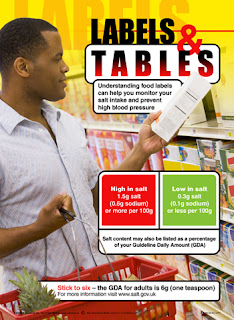 |
| 1 |
 |
| 2 |
 |
| 3 |
We now know more about diet and nutrition than ever before yet, as a nation, we are facing an obesity epidemic.
To cope with rising food prices and longer working hours it seems we are increasingly turning to cheaper convenience foods and pre-prepared ready meals.
The GDA labelling system was introduced in 2007 in a bid to help consumers make more informed choices about the food they buy. The labels show the amount of calories, sugars, fat, saturates and salt in units and as a percentage of a woman's Guideline Daily Amount (GDA). This is because the GDAs for women are lower than for men.
Research shows that the average amount of time a consumer will spend reading a label before putting the item into their trolley is just four seconds. This does not allow much time to fully assess the labels.
Three pieces of advice:
Firstly, consumers should always refer to the GDA label and make sure they know how to read it. No matter what other health claims are on the packaging – for example that the product is 'light' or 'one of your five-a-day' – the GDA label is the one they should rely on.
Secondly, consumers should be aware that many GDA labels do not refer to the contents of a whole pack. For example, the labels on some pizzas show the GDAs for just a one-quarter portion – not the whole thing.
Thirdly, around 80% of our daily salt intake is hidden in processed foods like bread, cereals and canned foods. Too much salt increases the risk of high blood pressure, heart attacks and strokes, so it is very important for consumers to monitor their intake.
So what does all this have to do with your workplace and your employees?
In the short-term, eating healthy foods can boost the immune system. This means your employees are less likely to be ill and less likely to be absent from work.
The foods we eat during the day can also affect our performance at work. For example, foods that are heavy or high in fat can cause drowsiness and slow reaction times. Indeed research shows that drivers are more likely to have accidents after lunch.
In the long term, educating your employees about healthy eating will help them to understand their GDAs and make more informed food choices as a result.
Eating healthily and maintaining a healthy weight can also stave off more serious and debilitating conditions, like heart disease and diabetes.
Kodiak's motivational poster programme regularly covers the benefits of good diet and weight control to keep your employees fit and healthy.
Our database has many posters on healthy eating, weight loss, heart health, diabetes and other related issues.
If you would like to find out more about how they can improve health and wellness in your workplace, please contact us.
For daily tips on dealing with common workplace issues, why not follow us on Twitter.
If you would like to find out how Kodiak posters
can help your business work smoother, smarter
and safer, please call us on: 01530 456 000
or email us.

No comments:
Post a Comment